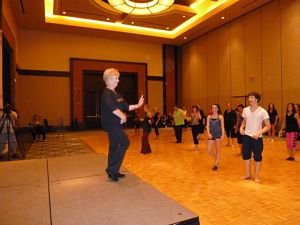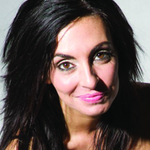
From my experiences as both a student and a teacher, what I have come to recognize is that learning the why’s and how’s of technique, composition, history, anatomy, etc, is what ultimately separates the dancer who watches, repeats and may perform well with that who becomes an artist of their craft. Getting young students to value the importance of where things come from, how a technique evolved, who the pioneers of a certain genre were and what their contributions to dance were, how a particular muscle works to achieve a desired position, the back-history of a musical, how changing the effort quality of a movement changes intent in a work, etc, can catapult our students into what I call “whole dancers” as opposed to solely trained moving vehicles; those literally just going through the motions.
A believer in putting theory into practice, it is a worthy notion to contemplate as both teacher and studio owner. Taking the time to reflect on your studio values and teaching philosophies may inspire you to give your dancers the opportunity to explore the “other side” of dance. This just may ignite them to comprehend technique better, sharpen their stylistic sensibilities and enhance stage presence. Most of all they come to understand why they are doing something, not just how.
To get a better glimpse of what I’m talking about, I’ll use my students as examples. Now, I should disclose that when I first tried this, there were some raised eyebrows in the studio, but because of the culture of the studios I teach at and the precedent that the studio directors have already set up, our students were already accustomed to learning all facets of dance. I will say now, students in my modern, composition and musical theatre classes look forward to mini- projects once in a while where dance class is anchored by discussion of their findings before we delve into a new technique, style, warm-up, piece, etc. They come away with more conceptual knowledge and understanding even before movement occurs. My hope is that their own ideas of theory and discovery transfer over into how they learn and execute movement; while coming to understand what distinguishes their art and each thing they learn.
To give you an idea of what I’ve done in my classes, I’ll give you some specific examples. Now keep in mind, with the academic stress of school you don’t want your students to feel overwhelmed with one more thing to do, or have parents who may not understand the value of this tool complain or question why you are giving dancers homework in a studio setting. However once they recognize the value of doing this periodically to broaden the knowledge-base, so that you are training “thinking dancers,” they will appreciate your efforts. So always keep it fun, light and allow the kids the opportunity to do the projects however they will enjoy it most!
I give mini-assignments across all age levels I teach (ages 12-18) and it is important to recognize that what I’m giving them is not a 50 page research paper, but simple, easy, quick things they can look up which give them a broader perspective into what they are learning in technique class. First, all students are to bring a binder and notebook to all classes. I will ask them to jot down things like vocabulary words, choreography notes, artists and composers of the music we are using in class, etc. I also encourage the dancers to use their notebooks as journals where they can write at the end or after their class about any feelings they had about what they did, felt, learned, experienced that day. This journal is solely for them but what it does is teach them not only how to dance but how to clearly articulate dance and their experiences.
In musical theatre last year, the kids were asked to find a movie musical prior to 1960, watch it and talk about it with the class. They could do this alone or with a partner. My goal was to expose them to classic musicals they might never have watched on their own. Some came in with poster-boards, collages, clips of favorite dance numbers from the movie, etc. But, I gave them no restriction on how they wanted to present. Another project included picking a famous musical theatre choreographer and sharing their background and contributions to the genre. Sometimes mini-assignments are also stimulated from actual class time itself. My pre-teen’s obsession with the song “Mr. Bojangles” turned into them going home and jotting down who Bill “Bojangles” Robinson was. Their love of “I’ll be Seeing You” during stretch time, turned into going home and jotting down their 3 favorite Billie Holiday songs, etc, etc, etc. The point is it shouldn’t feel like work for them, but rather something engaging.
Currently in my modern class we began working on Graham technique this year. To my surprise, a lot knew very little about her. Week one began with, “go home and find some basic info on her and the technique.” In the second week, I encouraged the dancers to go on you-tube and find their favorite Graham work and write about it. Week three stemmed from their own observations of Graham’s many influential published quotes. So they were to find their favorite quote which resonated with them most, and keep it in their binders as their inspiration for accomplishing their goals this year. I will say, not only has their knowledge increased but over the course of the past few weeks, the way they approach the movement and understand the nuances of the technique has drastically improved. Their connection and understanding of both the physical and historical content knowledge is beginning to cohesively combine. Last year the dancers learned about Isadora Duncan in the same way and to my surprise many of them came in and asked me about further reading materials on her. With my preteen class we explored their profound thoughts on whether they believed dancers were also artists and what they thought the similarities and differences were. Just last week, someone pointed to their iliopsoas and said, “I need a stretch for this area.” This turned into, “go home and look up the iliopsoas muscle and what its main function is.”
So you see, there are endless ways in which to bring content knowledge to technical training. Always remember to give back all the papers, projects, etc, to the dancers so they can keep them in their binders. By the end of the year they have their own portfolios full of wonderful resources separated by each technique! Many students have told me they have referred to these binders when they have research projects assigned at school too! Another great idea is using their collages, posters, etc, around your studio as a gallery of their work! The main thing is to get the dancers excited about what they are learning and soon enough the combination of content knowledge and technical training will set your dancers apart from the rest!
Good luck!
See you in the dance studio,
Jess

